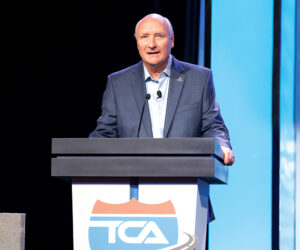If you take a moment to think back on your childhood, you can probably remember watching your grandma baking a cake or making up some other treat for the family.
There was no perfected recipe printed on the side of the sack of flour or scrawled on an index card. Her method? Just throw in an unspecified amount of flour, some eggs, baking soda, and milk; stir in the ingredients and bake.
Most of the time, the result was tasty … but occasionally not.
Until three years ago, becoming an entry-level truck driver was a similar type of endeavor — learn to drive, one way or another, then swing by to take a test and go home with either a chauffeur’s license or a commercial driver’s license (CDL), depending on when you started.
Now, however, the process is precisely governed, thanks to the Minimum Training Requirements for Entry-Level Commercial Motor Vehicle Operators final rule that was adopted February 6, 2017, by the Federal Motor Carrier Safety Administration (FMCSA).
Originally, the compliance date was set for February 7, 2020. It was later extended to February 7, 2022, to ensure truck driver training schools had sufficient time to prepare for the new structured rule.
“Prior to the new rule, the only rule in place required drivers to be trained via instruction on driver qualification, hours of service, driver wellness, and whistleblower protection,” noted Truckload Carriers Association’s (TCA) Vice President of Government Affairs David Heller. Heller was a member of the Entry-Level Driver Training Advisory Committee (ELDTAC) that advised FMCSA in the development of the new rule.
“The prior rule did not advocate for any sort of curriculum-based training,” he added.
Heller listed what he and others in the trucking industry feel are the three most important aspects of the new rule:
- It creates a minimum standard of training that every entity must train to, whether you are a carrier, a school, or even an independent contractor who trains their child to enter the business.
- It provides a competency standard for driving skills where students must show proficiency to obtain their CDL — among them, driving skills such as backing, turning, parking, etc., that previously didn’t exist in any training rule.
- It creates a registry of training providers that must register with FMCSA in order to certify they are training to that standard.
“Prior to this new rule going into effect, it was almost like the ‘wild, wild west,’” said Heller.
“In terms of training entry-level drivers, you had what we call CDL mills — people that train drivers in a very ‘fast-food’ type of situation. ‘Get ’em in, get ’em out, get ’em trained’ with no real attention to safety,” he explained. “Whereas now, because of the minimum standards that were put in place with the new rule, it’s a more streamlined and regulated type of environment. Effectively we are training all entry level drivers to the same minimum standard.”
TCA is a supporter of the new rule, Heller said.
“Certainly, without a doubt, the competency-based approach was one which we advocated for,” he stated. “We pride ourselves in putting safety first on the roads today. Ensuring that the drivers that graduate or complete this curriculum have safety first in mind is a safe approach to operating the commercial motor vehicle.”
Houston Community College’s Director of Transportation and National Association of Publicly Funded Truck Driving Schools’ (NASPFTDS) Executive Director Martin Garsee was also a member of the advisory committee. He feels the time lapse between passage of the new rule and the compliance date has given most truck driving schools time to prepare.
“Most public school programs were close to the standard, since the standard reflected a lot of the content from the module curriculum from the 1980s, and also the Professional Truck Driving Institute (PTDI) curriculum with updates to reflect the industry (such as e-logs, automatic transmission, DEF, and other technology,” explained Garsee.
“For most schools there was record-keeping of hours behind the wheel (BTW) and classroom, but with entry-level driver training (ELDT), the classroom/theory does not require hours reported,” he continued. “It does require a grade of 80% or better in the theory portion. For the BTW, the hours for range and road training have to be reported separately to FMCSA.”
PTDI was the only organization that issued curriculum guidelines — and schools were not obligated to follow them. The PTDI board issued a statement that it has, in light of the new regulations, ceased operation and will be voting to disband.
Garsee said he believes most private truck-driving training schools registered through state agencies that receive federal or state funds were probably close or already compliant with the new regulations. However, he said, outfits that rent trucks for a few hours for a person to take a test — with little or no training — will be the ones that should not be on the training provider registry established by the new rule, which stats that a training provider must meet all federal and state guidelines.
Garsee was asked if he felt the new rule could result in some carriers dropping their training programs and increasing reliance on publicly-funded schools.
“I have fielded a lot of calls with companies trying to decide if they want to continue training or contract it out,” he replied. “The companies that train only a few a year have, in some cases, already turned their training over to a school. The large carriers that have schools I believe will continue to train.”
Within the trucking industry there is not only talk about the new rule, but also about the FMCSA apprenticeship program designed to attract 18- to 20-year-olds to driving careers. The training of these drivers will be governed by the new rule.
“I think we will have to have some more time for this to show up in schools,” said Garsee.
“The questions are, will companies hire an 18-year-old, and will insurance companies cover 18-year-olds?” he added. “I believe we need to engage potential drivers at a younger age, but (I wonder) how much of the industry will accept them. For example, an 18-year-old can drive from Orange, Texas, to El Paso, Texas — almost 900 miles — but under the current rules can’t drive from Orange to Lake Charles, Louisiana, a distance of 20 miles.”
So here we are, two months into a new, carefully thought out “recipe” for training entry-level truck drivers. Will the plan result in more competent and safe truck drivers? Only time will tell.
Cliff Abbott of the Truckload Authority staff contributed to this story.
Lyndon Finney’s publishing career spans over 55 years beginning with a reporter position with the Southwest Times Record in Fort Smith, Arkansas, in 1965. Since then he’s been a newspaper editor at the Southwest Times Record, served five years as assistant managing editor of the Arkansas Democrat-Gazette in Little Rock and from November 2004 through December 2019 served as editor of The Trucker. Between newspaper jobs he spent 14 years as director of communications at Baptist Health, Arkansas’ largest healthcare system. In addition to his publishing career he served for 46 years as organist at Little Rock’s largest Baptist church.








